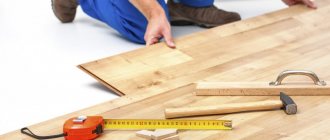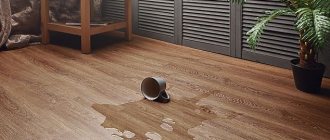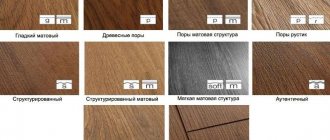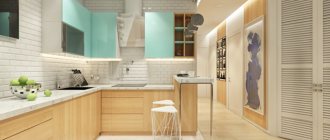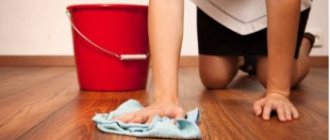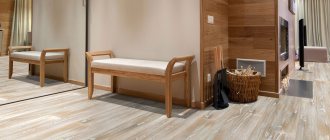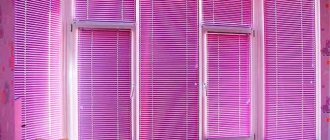Major home renovations usually involve changing the flooring. A material such as laminate is practical and convenient. It combines some of the qualities of linoleum and externally imitates wooden plank floors or parquet.
Laminate flooring is very easy to install and does not require careful maintenance. This coating would be a good option in a home with small children.
Laminate can withstand any impact. For example, he is not afraid of an overturned pan of boiling water or spilled paint. This type of flooring is available in a wide range with various patterns and ornaments.
Helpful information ! In addition to the classic wood design, nowadays you can see original carpet patterns, coverings that imitate marble, etc.
It is worth noting that laminate, like other flooring options, has some disadvantages. First of all, it is worth noting their fragility.
Its service life is no more than 5-6 years. This is due to the fact that the bottom layer of the laminate board is chipboard or fiberboard. Therefore, laminate, just like wood, is characterized by high porosity and over time it begins to warp.
What is the underlay for?
To ensure that the laminate does not lose its original appearance for as long as possible, you need to use an underlay for this floor covering. In addition, it will act as a shock absorber and prevent subsidence and deformation of the coating when it is subject to loads. Substrates are different and each of them has both its pros and cons.
Izolon and polystyrene
Izolon is a material in the form of foamed polyethylene. This type of substrate has an acceptable cost. It is able to withstand the influence of moisture and the occurrence of fungus, which often affects wooden surfaces. But isolon has one drawback—its short lifespan.
Isolon breaks easily and sags very quickly under load, so it cannot cope with the task of shock absorption. However, it has good sound insulation, which makes it especially popular. Under the laminate, the isolon is connected by gluing with tape.
Laminate installation diagram
Polystyrene is a more expensive material with a two-layer structure. A thin layer of aluminum foil is placed on top of the polyesterol layer.
In order to connect the pieces of polystyrene placed under the laminate, you will need adhesive tape made of aluminum staniol, which can be purchased at any hardware store. Laying polystyrene involves great difficulties, unlike isolon. This is due to the fact that it does not roll out well.
It fills voids well, but under the influence of load it is greatly deformed and sags.
Cork backing
Cork backing is the most expensive option available. But the high cost only indicates the appropriate quality of the material.
Important ! Cork has excellent noise and heat insulation qualities, and also does an excellent job of shock absorption. If there is a substrate of this type under the laminate, it will not sag or deform under the influence of loads for a long time.
Moreover, it is of natural origin and does not contain heavy chemical compounds that are harmful to the human body.
If we talk about the disadvantages of a cork substrate, then they include the fact that it does not withstand moisture well. In order to neutralize this drawback, it must be coated with a waterproof compound.
In this case, tar will be the best option. In order to protect the substrate from moisture emanating from the concrete floor, it should be laid on glassine or greenhouse film. Today on sale there is a cork substrate that has a rubberized base or a version with bitumen.
Having decided to use a cork backing, you need to know that its thickness should be within 4 mm. The most optimal indicator is 2-3 mm.
A thicker underlay, in combination with an uneven floor, will lead to large joints between the tiles, as a result of which the floor surface will not look aesthetically pleasing. Before you begin laying the laminate, the floor should be leveled.
The substrate is not able to smooth out all its defects and irregularities. In addition, this will have a positive effect on the service life of the flooring material.
Procedure for laying laminate flooring
Which installation scheme should I choose?
In fact, there are a lot of installation schemes, but a beginner does not need to experiment - he risks making a mistake, which threatens to buy another package of laminate to replace the damaged one. Let's look at the basic schemes.
Classic. Laying laminate flooring according to this scheme is considered the simplest and most economical, since only about 5% of the material will be wasted. Its essence is that each new row is shifted relative to the previous one and begins with the remainder of the cut board of the newly laid row. If the dimensions of the room allow, then you can start a new row with a lamella shortened by 1/3, and use the cut parts at the end of the row.
Chess. With this installation scheme, the lamella of the second row is cut in half. The laid covering resembles brickwork. The consumption of laminate depends on the size of the room - if the slats of the first row are made without trimming, then there will be a minimum of waste. It’s worth noting right away that such a coincidence is very rare, so you need to tune in to a higher material consumption - about 10%.
Diagonal. This installation scheme will require some skills. Often, beginners cut slats at the wrong length, or on the wrong side, or make an angle in the wrong direction. Due to the large number of scraps that cannot be used anywhere, the minimum amount of waste will be about 20%, and if mistakes are made, it can reach up to 30%.
Having assessed your strengths, abilities and material capabilities, choose the optimal installation method. It is important to take into account that it is not recommended to use residues from lamellas less than 30 cm.
Wood fiber substrates
Wood-fiber substrates are presented in the form of slabs laid under the laminate. They perfectly dampen the sounds of footsteps, but are powerless in the fight against penetrating noise.
Helpful information ! If you want to protect yourself from the sounds of noisy neighbors, you should abandon this type of substrate. The main advantage of this material is thermal insulation, so it will be an ideal option for rooms on the first floors where the floor is always cold.
- In order to enhance the effectiveness of the wood-fiber backing, the slabs must be laid perpendicularly.
- Many craftsmen recommend placing them at an angle of 45° to the direction of the checkers. Adjacent rows can be shifted relative to each other by ? slab length.
- A distance of 2 mm should be provided between the slabs, the distance from the slab to the wall is 1 cm. In this case, during temperature changes in the air, the deformed substrate will not compress the floor covering.
Laying laminate (step by step instructions)
Now we’ll tell you how you can do the installation yourself. Step-by-step instructions on how to lay laminate flooring will help us with this.
Tool
To do the job you will need the following tool:
- Circular saw or jigsaw.
- Hammer.
- Bracket (a special tool, without which it is extremely difficult to hammer in the outer slats).
- Spacer wedges (you can use wooden pegs).
- A tape measure, a construction square and a simple pencil.
In addition to the tool, you will need a wooden block - we will use it to tap the lamellas, using it as a buffer between the laminate and the hammer.
Specialized substrates
Specialized substrates are made from non-traditional materials that are manufactured by various construction companies. Such options include polymer porous substrates, etc.
Important! It is quite difficult to assess the advantages and disadvantages of these substrates, since the manufacturer often conceals their structure. However, specialized substrates are usually of good quality and provide all the necessary functions.
A good alternative to the traditional underlay would be its liquid variety, which involves an adhesive mass connecting the laminate to the base. In this case, the mass will not prevent the deformation of the laminate during fluctuations in room temperature and air humidity. The mass retains its elasticity and dampens noise well.
Fiberboard substrates have excellent sound and heat insulation. Their disadvantage is high porosity, as a result of which this kind of substrate is not able to withstand the influence of moisture.
By taking certain precautions, you can extend the life of the material. If moisture penetrates under the laminate, this will not lead to its deformation, but if water regularly enters it, it may become damaged. Therefore, it is necessary to provide it with proper operating conditions or cover the fiberboard panels with appropriate waterproof materials.
Fibreboard substrates, just like fiber products, must be laid at an angle of 45 ° to the laminate dies, which will help prevent the gaps from matching. It is important that there is a gap of 1-2 mm between the slabs, and 5-10 mm between the slab and the wall.
The stability of the slab can be increased by gluing it to the floor at several points. Another option is to attach it with staples or nails.
How to choose a laminate
When choosing a laminate, it is very important to pay attention not only to its appearance (although this is also important), but also to other characteristics:
- impact resistance;
- moisture resistance;
- wear resistance.
For example, it is advisable to purchase a wear-resistant laminate for the corridor, and moisture-resistant one for the kitchen and bathroom. However, everyone has the right to decide for themselves what suits them, so we are only giving a recommendation.
Classes
When choosing a laminate, you need to know that it is divided into classes:
- 34th grade. This laminate has the most wear-resistant coating, but given its high cost, many people consider it inappropriate to use it in an apartment.
- 33rd grade. Laminate of this class is quite in demand. Most often used in places with heavy load on it.
- 32nd grade. The most popular class of laminate. For an apartment in which a family of several people lives, it can be an ideal choice, taking into account the price-quality ratio.
- 31st grade. The quality of this coating is very low, and its service life is only 6 years. Despite the lowest price, such an acquisition will not be profitable, since it will not last long.
Connection method
So that later there are no questions about how to lay the laminate, you need to decide in advance on the type of connection of the lamellas.
Click lock
Laminate flooring with the Click locking system is in great demand, as its installation is quite simple. Another board is inserted into a board lying on the floor at an angle of about 30° and slowly lowered. A characteristic click will be a signal that the boards have connected. For a tighter connection, the inserted board will need to be padded. The disadvantage of this system is the need to strictly observe the required angle, otherwise the lock may break.
Lock
Laminate with the Lock system is used less frequently. To connect, two boards need to be laid horizontally and inserted into one another until they snap into place, after which they are adjusted to each other using a hammer and a block.
Glue method
The adhesive method helps make the coating durable and more moisture resistant. Nothing changes in the technology of connecting the boards, only glue is added to the lock during assembly. It is important to consider that it will be simply impossible to disassemble the floor to replace one of the boards.
Our short review will help you purchase high-quality coverage at a reasonable price that will last a long time.
How much laminate will be required?
Some manufacturers indicate the total area of the laminate in the package, while others only indicate the number and dimensions of the lamellas, which does not prevent you from calculating the area yourself.
For example, the dimensions of your room are 4x4 m. Multiply these numbers and get 16 m2.
Let’s assume that the packaging of the laminate you like is capable of covering an area of 2.663 m2.
Let's do the following calculation:
16:2,663=6,008
It turns out that in terms of area we will need a little more than 6 packages of laminate. However, you need to add 10% (or 20% when laying diagonally). Let's do the calculation:
6×0,1=0,6
Calculations showed that 10% is 0.6 packs. Let's calculate the total required amount of laminate:
6+0,6=6,6
Since laminate is not sold individually, we will round up. It turned out to be 7 packages.
Coniferous tiles
Coniferous underlay for laminate flooring is an innovation that appeared on the commercial market relatively recently. The cost of such material is quite high, so sometimes finding it in construction stores is not so easy.
You can often see Izoplat coniferous boards on sale. This type of material has environmentally friendly qualities and is capable of allowing air to pass through, thanks to which the greenhouse effect can be prevented.
If we talk about elasticity, then pine needles cannot compete with cork. Tiles made of pine needles have a thickness of 4-5 mm, which does not meet the requirements of laminate manufacturers. The substrate is laid diagonally.
Bitumen-cork substrates
The basis of this material is kraft paper in combination with bitumen. Fine cork chips are applied on top of the material. Crushed pieces of cork (2-3 mm) are used as topping.
Bitumen is characterized by the fact that it does not allow moisture to pass through, is able to retain sounds, is breathable, and therefore does not allow the formation of condensation. The cost of the bitumen substrate is quite high, so it is advisable to lay it under expensive types of laminate. Conclusion
Using a laminate underlay is not a requirement. However, without it, it will be necessary to carry out repeated repairs after 5-6 years. You can extend the life of the laminate by laying panels and special slabs.
Their task is to protect the house from extraneous noise and cold. In addition, they prevent deformation of the laminate flooring.

